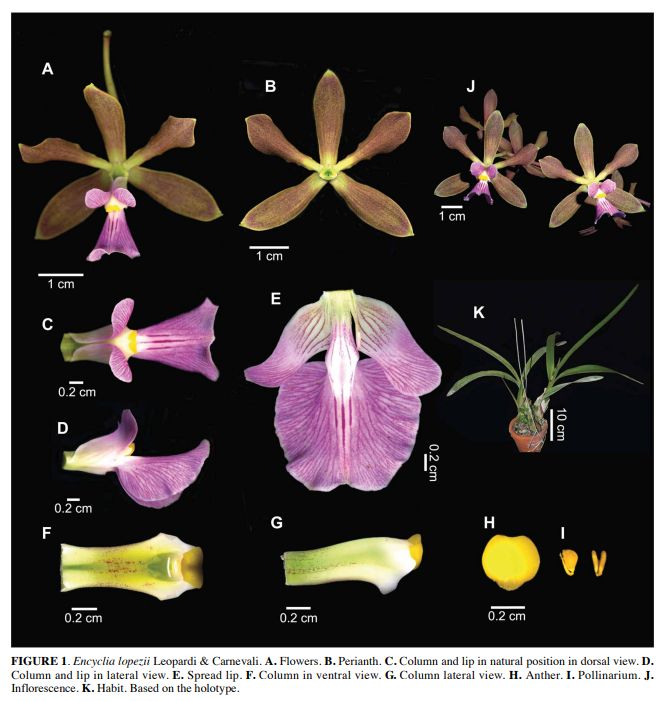

Encyclia lopezii Leopardi & Carnevali 2012
LCDP Photo by © Leopardi & Carnevali

 LATER
LATER
Common Name Lopez's Encyclia [Ramon Lopez Venezuelan discoverer of species current]
Flower Size 1.6" [4 cm]
Found in Zulia and Trujillo states of Venezuela at elevations around 2000 to 2200 meters as a medium sized, cold growing epiphyte with clustered but shortly creeping, ovoid pseudobulbs that are green and smooth in youth, purplish red tinged and finely wrinkled when old, when young clothed in white papyraceous, non-persistent sheaths carrying 2, apical, narrowly oblong elliptic, somewhat twisted, thick, rigid, midnerve carinate mainly in the lower half leaves that blooms in the later spring on a terminal, erect or somewhat arching, raceme or panicle, peduncle thin but fairly strong, upper portion of peduncle, rachis and pedicellate ovaries verrucose, the remainder lightly rough, the verrucae paler than the rest of the peduncle, all of the inflorescence is lightly to heavily tinged with purple, to 18" [45 cm] long, 4 to 7 flowered inflorescence.
"Encyclia lopezii is phenetically closest to Encyclia cordigera. They share the large flowers, the broad, suborbicular-subquadrate central lobe of the labellum, and the obovate to spathulate petals. It mainly differs, however, in the subapically winged column with straight margins, the verrucose pedicellate ovary, and the apices of the lateral lobes not overlapping on top of the column at anthesis. At the type locality, Encyclia lopezii is sympatric with E. cordigera and an Andean form of E. diurna. From E. diurna it is easily distinguished by its larger flowers with broader midlobe of a pale lavender to pale pink color. The pedicellate ovary of E. diurna is more coarsely verrucose than that of E. lopezii, which also has smaller auricles. Encyclia lopezii might be a hybrid between the pink-lipped form of E. cordigera and E. diurna, since it appears to be intermediate in several character states. It resembles the former because it has a similar flower texture, color pattern in tepals and labellum, as well as absence of warts on the rachis. Encyclia lopezii shares with E. diurna the callus architecture, the presence and shape of the auricles (column wings), the magenta longitudinal lines in the labellum central lobe (not the purple spot commonly seems in E. cordigera), and the presence of warts in the pedicellate ovary (for comparisons see Fig. 1–2). We hesitate to propose this entity as a nothospecies at this time since it is fairly common in nature, as opposed to most orchid natural hybrids that tend to occur as isolated individuals among populations of the putative parental species. It is also known from at least two different localities. We intend to explore this hypothesis further: as a first approximation, we will attempt to analyze DNA sequences of E. lopezii to place it within our phylogenetic analyses of the genus looking for incongruences between nuclear and plastid sequences. Furthermore, Encyclia lopezii is phenetically similar to E. spiritusanctensis from SE Brazil, but it is easily distinguished because the plants of the Brazilian species are more robust with broader leaves (ca. 1.4 vs 1" [3.5 cm vs. 2.5 cm] in E. lopezii). Moreover, the flowers are larger (1.6 to 2" [4 to 5 cm] across the spread apices of the petals vs. 1.4 to 1.6" [3.5 to 4 cm] in E. lopezii) with proportionally much broader petals. Plants of Encyclia spiritusanctensis are lithophytic whereas those of E. lopezii are epiphytic. Our preliminary phylogenetic analyses indicate that Encyclia species group in assemblages restricted to particular biogeographical areas. Also, vegetative patterns are better predictors of phylogenetic relationships than floral morphology, which is highly homoplasious at deeper phylogenetic levels. Thus, it is safe at this time to hypothesize that the Andean Venezuelan and the SE Brazilian species are not closely related and floral similarities are most likely due to evolutionary convergence driven by the use of similar pollinators." Leopardi & Carnevali 2012
Synonyms
References W3 Tropicos, Kew Monocot list , IPNI ;
* Phytotaxa 48: 24 Leopardi & Carnevali 2012 Photos fide;
----------------------------------------------------------------------------------------------------------
------------------------------------------------------------------------------------------------------------------------